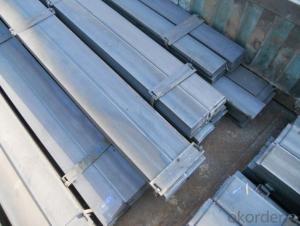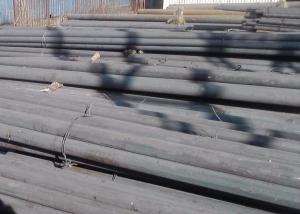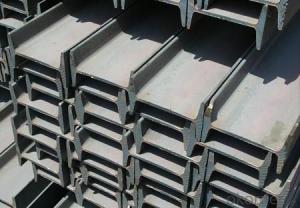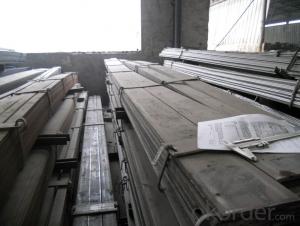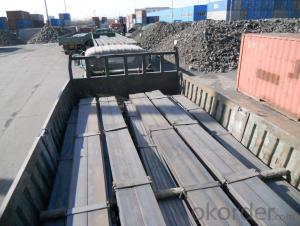Carbon steel flat bars with high quality and low price
- Loading Port:
- Tianjin
- Payment Terms:
- TT OR LC
- Min Order Qty:
- 25 m.t.
- Supply Capability:
- 100000 m.t./month
OKorder Service Pledge
OKorder Financial Service
You Might Also Like
Mild Steel Flat Bar Details:
| Minimum Order Quantity: | 25 m.t. | Unit: | m.t. | Loading Port: | China Main Port |
| Supply Ability: | 80000-100000MTS/YEAR m.t./month | Payment Terms: | TT or LC |
Product Description:
Specification of Mild Steel Flat Bar
Commodity: Mild Steel Flat Bar
Standard: GB;JIS
Material: Q195-235;SS400
Brand name: FLATSPACE
Origin place: China
Thickness: 3mm-30mm
Width:20mm-200mm
Length: Max 12m
Certification: SGS/BV
Chemical composition of Q235
Alloy No | Grade | Element(%) | ||||
C
| Mn
| S
| P
| Si
| ||
Q235
|
B
|
0.12—0.20 |
0.3—0.7 |
≤0.045 |
≤0.045
|
≤0.3
|
Physical properties of Q235
Alloy No | Grade | Yielding strength point(Mpa) | Tensile strength (Mpa) | Elongation after fracture(%) | ||||||
Thickness (mm) | Thickness (mm) | |||||||||
≤16 | >16--40 | >40--60 | >60--100 | ≤16 | >16--40 | >40--60 | >60--100 | |||
≥ | ≥ | |||||||||
Q235 |
B |
235 |
225 |
215 |
205 |
375--500 |
26 |
25 |
24 |
23 |
Usage/Applications of Mild Steel Flat Bar
Widely used for construction, Machinery manufacturing, Iron tower steel structure, Shipbuilding; Steel grating, Staircase, Bridge, Viaduct, Railway spare parts, Boilers making etc.
Packaging & Delivery of Mild Steel Flat Bar
Packaging Details: The Mild Steel Flat Bars are packed in bundles and loaded in 20 feet/40 feet container, or shipped by bulk cargo ,also we can do as customer's requirements.
Delivery Details:30~45 days upon the receipt of buyer payment by T.T. or L/C.
Production Flow of Mild Steel Flat Bar
The Mild steel flat bar is made through three processes:
1.Feeding the material: Feeding the row material (the steel plate) to Slitting Line.
2.Slitting:The steel plate would be slitted into expected width by lengthways cutter.
3. Leveled and cutting: The plat bar would be ground into level by the grinder and then cut into required length.
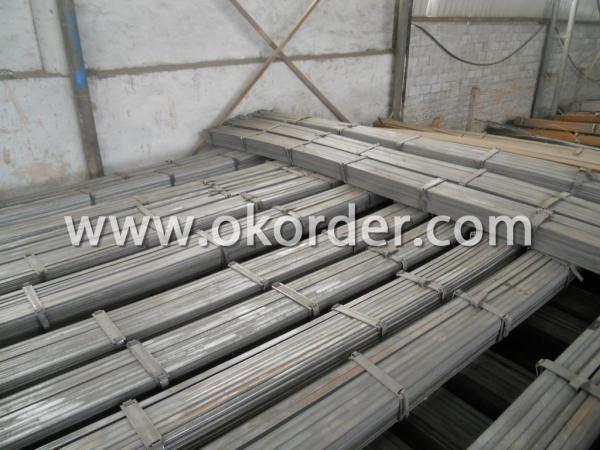
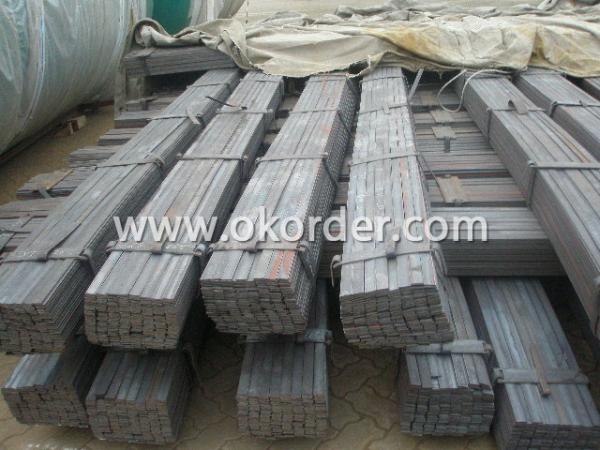
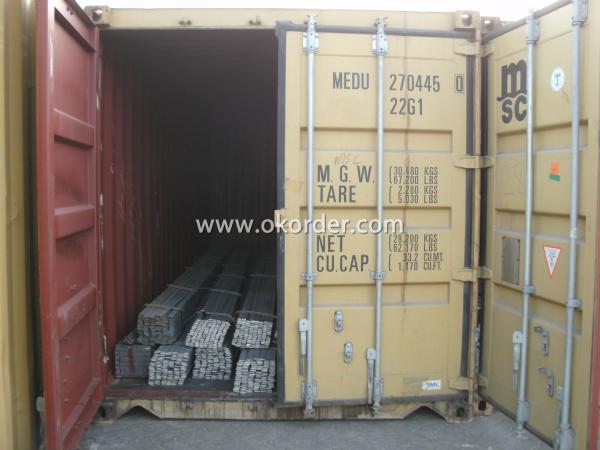
FLATSPACE is specialized in production and sales of slit flat bars. We offered the individuation processing service of slitting and crosscut. Our flat bar the width form 10mm to 1800mm, and thichness from 2.5mm to 25mm.
View Manufacturer's Shop
1. Manufacturer Overview | |
|---|---|
| Location | Hebei, China |
| Year Established | 2009 |
| Annual Output Value | Above US$ 150 Million |
| Main Markets | Southeast Aisa, Middle east, Africa |
| Company Certifications | |
2. Manufacturer Certificates | |
|---|---|
| a) Certification Name | |
| Range | |
| Reference | |
| Validity Period | |
3. Manufacturer Capability | |
|---|---|
| a)Trade Capacity | |
| Nearest Port | Tianjin |
| Export Percentage | 70%-80% |
| No.of Employees in Trade Department | 10-15 people |
| Language Spoken: | English; Chinese |
| b)Factory Information | |
| Factory Size: | Above 20,000 square meters |
| No. of Production Lines | 7 |
| Contract Manufacturing | OEM Service Offered; |
| Product Price Range | Average |
- Q:Are steel flat bars suitable for agricultural applications?
- Indeed, agricultural applications can certainly benefit from the use of steel flat bars. Steel, being an incredibly resilient and robust material, can easily endure the strenuous demands imposed by agricultural activities. These flat bars find utility in a wide array of agricultural applications, including the construction of equipment and machinery, the erection of structures and fences, and even for general repairs and maintenance tasks. With their exceptional strength and stability, steel flat bars exhibit the capability to withstand heavy loads and the harshest weather conditions. Moreover, their versatility allows for easy shaping and welding, thus permitting customization to meet specific requirements. Ultimately, when it comes to agricultural applications, steel flat bars present themselves as a dependable and enduring choice.
- Q:Are steel flat bars available in different thicknesses?
- Yes, steel flat bars are available in different thicknesses. Steel flat bars come in a variety of sizes and dimensions to suit various applications. The thickness of a steel flat bar can range from very thin, such as 1/8 inch or 3.18 mm, to much thicker options like 1 inch or 25.4 mm. The availability of different thicknesses allows for versatility in their use, whether it be for construction, manufacturing, or other industrial applications.
- Q:What are the common standards or specifications for steel flat bars?
- The common standards or specifications for steel flat bars include ASTM A36, ASTM A529-50, and ASTM A572-50. These standards define the chemical composition, mechanical properties, and dimensional tolerances of steel flat bars, ensuring their quality and compatibility with various applications.
- Q:What are the applications of steel flat bars?
- Steel flat bars have a wide range of applications across various industries. One of the most common uses is in construction and structural engineering. Steel flat bars are often used as a structural component in buildings, bridges, and other infrastructure projects. They provide strength and stability to these structures and can withstand heavy loads and forces. In the manufacturing industry, steel flat bars are utilized in the production of machinery and equipment. They are commonly used as a base or support for heavy machinery, as well as in the construction of frames, brackets, and components. The high strength and durability of steel flat bars make them ideal for these applications, as they can withstand the stress and pressure generated during operation. Steel flat bars also have applications in the automotive industry. They are often used in the manufacturing of vehicle frames, chassis, and body panels. The strength and rigidity of steel flat bars ensure the structural integrity of automobiles, providing safety and stability to the vehicle. Moreover, steel flat bars find applications in the fabrication industry. They are commonly used in the production of gates, fences, grills, and handrails. The versatility of steel flat bars allows them to be easily shaped, cut, and welded, making them an ideal choice for custom fabrication projects. In addition to these industries, steel flat bars have various other applications. They are commonly used in the manufacturing of furniture, shelves, and storage racks due to their high load-bearing capacity. Steel flat bars are also utilized in the production of agricultural equipment, such as plows and harrows, as well as in the manufacturing of tools and hardware. Overall, the applications of steel flat bars are vast and diverse. Their strength, durability, and versatility make them a popular choice in construction, manufacturing, automotive, fabrication, and many other industries.
- Q:Are steel flat bars commonly used in the construction of recreational facilities?
- Steel flat bars are widely utilized in the construction of recreational facilities. Their versatility allows for various applications, including the development of sports stadiums, arenas, swimming pools, and amusement parks. These bars are commonly employed for structural support, framing, and reinforcement purposes due to their exceptional strength and durability. By providing stability and resistance against heavy loads, steel flat bars play a crucial role in creating robust and long-lasting recreational facilities. Moreover, their easy fabrication and customization enable them to meet specific design requirements, offering flexibility throughout the construction process. Ultimately, the incorporation of steel flat bars in recreational facility construction guarantees safety, reliability, and longevity, making them a prevalent choice in the industry.
- Q:Can steel flat bars be used in the manufacturing of fencing or gates?
- Yes, steel flat bars can definitely be used in the manufacturing of fencing or gates. Steel flat bars are strong and durable, making them an excellent choice for creating sturdy fences and gates that can withstand various weather conditions and provide security. These bars can be welded or bolted together to form the framework of the fencing or gates, offering stability and durability. Additionally, steel flat bars can be easily shaped and customized to meet specific design requirements, allowing for the creation of unique and visually appealing fences and gates.
- Q:What are the common methods of cutting steel flat bars?
- There are various techniques commonly employed for the cutting of steel flat bars. 1. Manual cutting entails the utilization of hand tools like hacksaws or bolt cutters to slice through the steel. Although it is a slower and more labor-intensive process, it is suitable for small-scale projects or situations where access to power tools is limited. 2. Abrasive cutting involves the use of abrasive wheels or discs to grind through the steel. This method is typically executed with a handheld angle grinder or a stationary abrasive saw. While abrasive cutting is relatively rapid and efficient, it may yield a rougher edge that necessitates further finishing. 3. Band saw cutting is frequently employed, utilizing band saws equipped with metal-cutting blades. This technique enables more precise and accurate cuts, especially for larger or thicker bars. Band saws are available in various sizes, including portable options for on-site cutting or larger industrial models for heavy-duty cutting. 4. Plasma cutting employs a high-velocity jet of ionized gas, known as plasma, to melt through the steel. This method is renowned for its speed and versatility, allowing for the cutting of different thicknesses of steel and the production of clean and precise cuts. Plasma cutting machines are commonly utilized in industrial settings. 5. Laser cutting involves the use of a high-powered laser beam to melt and vaporize the steel, resulting in a precise and smooth cut. This technique is highly accurate and capable of producing intricate designs or patterns. However, laser cutting machines can be costly and are typically utilized in specialized fabrication shops or manufacturing facilities. When selecting the appropriate method for cutting steel flat bars, it is essential to consider factors such as desired cut quality, accuracy, speed, and available resources.
- Q:How do steel flat bars perform in terms of UV resistance?
- Steel flat bars lack inherent UV resistance properties, making them susceptible to negative effects when exposed to ultraviolet (UV) radiation from sunlight. Extended exposure to UV rays can cause degradation and brittleness in steel over time, resulting in discoloration, oxidation, and structural weaknesses in flat bars. To address these issues and enhance UV resistance, various methods can be utilized. One commonly employed approach involves applying protective coatings, such as paint or specialized finishes, to the steel surface. These coatings act as a barrier, shielding the steel from direct UV exposure and preventing degradation. Moreover, stainless steel flat bars tend to exhibit superior resistance to UV radiation compared to carbon steel. This is due to the presence of chromium in stainless steel, which forms a passive oxide layer offering some natural UV protection. However, it is important to note that even stainless steel can still be affected by intense UV rays when exposed for prolonged periods. Ultimately, when considering the use of steel flat bars in outdoor or UV-exposed applications, it is essential to carefully consider the specific environment, level of UV exposure, and the necessity for additional protective measures. These considerations are crucial for ensuring the longevity and performance of the steel flat bars.
- Q:Building poles, outdoor flat steel, the deeper the buried depth, the better?
- The construction of outdoor flat steel at normal negative 1.5m or so, there is design requirements. Nor does it mean that the deeper the better. The main function of the outdoor ground flat steel is that when the lightning resistance of the main body of the building is not up to the design requirements, the artificial outdoor triangular steel pipe pile shall be added to the outdoor earthing flat steel until the ohm value is qualified. Normally, the outdoor ground flat steel does not work.
- Q:How do you determine the hardness of a steel flat bar?
- There are several methods available for determining the hardness of a steel flat bar, such as the Rockwell hardness test, Vickers hardness test, Brinell hardness test, or the Shore hardness test. The Rockwell hardness test is the most commonly used method for determining steel hardness. It involves applying a specific load and measuring the depth of penetration of an indenter into the flat bar's surface. This depth is then used to calculate the Rockwell hardness number, which indicates the steel's hardness level. Another frequently used method is the Vickers hardness test. This method involves pressing a diamond indenter into the flat bar's surface and measuring the size of the resulting indentation. The Vickers hardness number is determined based on the applied load and the surface area of the indentation. For softer steels, the Brinell hardness test is suitable. This method involves pressing a hardened steel ball into the flat bar's surface under a specific load. The diameter of the resulting indentation is measured, and the Brinell hardness number is calculated based on the applied load and the surface area of the indentation. The Shore hardness test, on the other hand, is commonly used for softer materials. It measures the resistance of the flat bar's surface to indentation using a durometer. The durometer measures the depth of penetration of a specific indenter and provides a hardness reading on the Shore hardness scale. Ultimately, the choice of method depends on factors such as the hardness range of the steel, available testing equipment, and required accuracy. Seeking guidance from a material testing professional or consulting applicable standards can help ensure accurate hardness evaluation.
1. Manufacturer Overview |
|
|---|---|
| Location | |
| Year Established | |
| Annual Output Value | |
| Main Markets | |
| Company Certifications | |
2. Manufacturer Certificates |
|
|---|---|
| a) Certification Name | |
| Range | |
| Reference | |
| Validity Period | |
3. Manufacturer Capability |
|
|---|---|
| a)Trade Capacity | |
| Nearest Port | |
| Export Percentage | |
| No.of Employees in Trade Department | |
| Language Spoken: | |
| b)Factory Information | |
| Factory Size: | |
| No. of Production Lines | |
| Contract Manufacturing | |
| Product Price Range | |
Send your message to us
Carbon steel flat bars with high quality and low price
- Loading Port:
- Tianjin
- Payment Terms:
- TT OR LC
- Min Order Qty:
- 25 m.t.
- Supply Capability:
- 100000 m.t./month
OKorder Service Pledge
OKorder Financial Service
Similar products
New products
Hot products
Hot Searches
Related keywords

